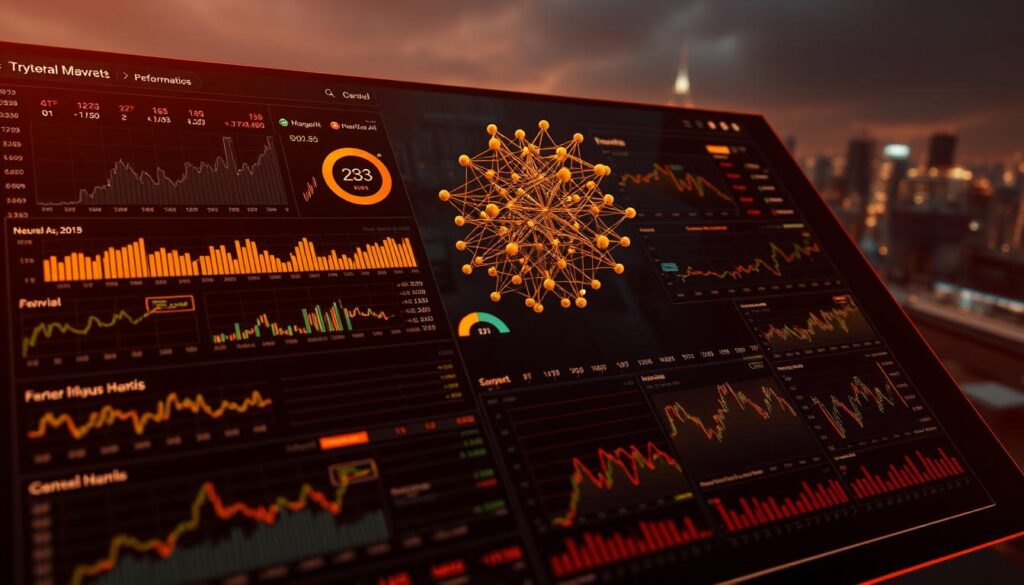Now Reading: Understanding Neural Network Crypto Pattern Recognition Techniques
- 01
Understanding Neural Network Crypto Pattern Recognition Techniques
Understanding Neural Network Crypto Pattern Recognition Techniques

The world of cryptocurrency trading has evolved dramatically in recent years. Traditional technical analysis methods are giving way to more sophisticated approaches. Advanced computational systems now process market data with unprecedented speed and accuracy.
Deep learning represents a breakthrough in how machines understand complex information. These systems analyze massive datasets to identify subtle relationships that human traders might overlook. The technology learns from historical patterns to predict future market movements.
Machine learning applications in digital asset markets combine multiple analytical approaches. They examine price trends, trading volume, and market sentiment simultaneously. This comprehensive analysis provides traders with actionable insights for making informed decisions.
The transition to data-driven strategies marks a significant shift in investment approaches. Rather than relying on intuition, traders can now use statistically validated methods. These systems continuously improve their performance through ongoing learning from market data.
Key Takeaways
- Advanced computational systems are transforming how we analyze cryptocurrency markets
- Deep learning technology can process complex market data more effectively than traditional methods
- Machine learning approaches examine multiple data dimensions simultaneously for comprehensive analysis
- Data-driven strategies provide statistically validated insights for trading decisions
- These systems continuously improve through ongoing learning from market patterns
- The technology helps identify subtle relationships that might escape human observation
- Modern trading approaches combine speed, accuracy, and comprehensive market analysis
Introduction to Neural Network Crypto Pattern Recognition
The landscape of digital asset analysis has undergone a fundamental transformation with the integration of artificial intelligence technologies. Machine learning systems now enable systematic identification of recurring market behaviors that indicate probable price movements.
These advanced computational approaches examine multiple data dimensions simultaneously. They process technical indicators, volume metrics, sentiment signals, and on-chain analytics through sophisticated architectures.
Purpose and Scope
This guide explains how deep learning differs from traditional technical analysis. The technology automatically discovers complex relationships between variables without manual feature engineering.
The scope covers comprehensive pattern detection across various market conditions. It addresses when historical relationships remain reliable and when they become invalidated.
Why This Guide Matters for Traders
Traders gain competitive advantages through faster detection capabilities and adaptive learning systems. These tools process information streams that exceed human cognitive capacity.
The content establishes realistic expectations about risk management requirements. While accuracy improves significantly, robust risk protocols remain essential for successful trading outcomes.
Overview of the Cryptocurrency Trading Landscape
The architecture of cryptocurrency trading platforms creates distinctive market dynamics unseen in conventional finance. Digital asset exchanges operate 24/7 across global time zones, generating continuous data streams. This constant activity produces unique trading patterns that sophisticated systems can analyze.
Market volatility represents both significant risk and substantial opportunity. Price movements in digital currencies often exceed traditional asset fluctuations. This creates potential for higher returns but demands careful risk management strategies.
The fragmented nature of cryptocurrency exchanges across multiple platforms introduces arbitrage possibilities. Different liquidity levels and pricing discrepancies occur simultaneously. Advanced analytical tools can navigate these complex market structures effectively.
Market Volatility and Opportunities
Digital currency markets attract diverse participants including retail investors, institutions, and protocol developers. Each group contributes distinct trading behaviors and market influences. This diversity creates rich data sources for identifying profitable trends.
Blockchain transparency provides unprecedented access to on-chain metrics. Wallet activity, transaction volumes, and token distribution data offer unique insights. These signals are unavailable in traditional financial markets.
Current market trends show growing institutional adoption and regulatory evolution. Participant sophistication continues to increase across the trading landscape. These developments shape both constraints and opportunities for market analysis.
The Evolution of Neural Networks in Trading Systems
Quantitative finance experienced a revolutionary transformation when computational systems began learning from market data. Early analytical methods depended on manual chart interpretation and basic indicators. These traditional approaches required significant human intervention and often missed complex relationships.
From Traditional Analysis to Deep Learning
The shift started with simple algorithms that could process limited data sets. These early attempts at machine learning in trading had restricted capabilities. They could only handle straightforward patterns and required constant manual updates.
Modern deep learning architectures changed everything by processing multi-dimensional data streams. These sophisticated models analyze millions of data points across various market dimensions. The transition represents a fundamental improvement in analytical power and adaptability.
Milestones in Neural Network Development
Artificial intelligence began with the 1956 Dartmouth Conference, establishing the field’s foundation. Progress slowed during periods known as “AI winters” when development stalled. The 2006 breakthrough by Hinton revitalized the entire industry with enhanced algorithms.
Critical technological advances enabled practical trading applications. GPU processing power and big data infrastructure supported complex model development. Improved architectures like CNNs and LSTMs could handle heterogeneous information streams effectively.
The evolution moved from rigid rule-based systems to adaptive learning approaches. Traditional indicators now serve as input features rather than standalone tools. This intelligent combination creates more robust trading strategies that continuously improve through exposure to market data.
Deep Learning Fundamentals in Crypto Trading
Deep learning represents a paradigm shift in how trading systems process market information. These advanced computational methods automatically extract meaningful features from raw data streams. This eliminates the need for manual feature engineering that plagued earlier analytical approaches.

Key Concepts and Terminology
Deep learning architectures use multiple processing layers to discover hierarchical patterns. Each layer transforms input data into increasingly abstract representations. This layered approach enables the discovery of complex relationships that simpler models might miss.
Critical components include activation functions that introduce nonlinearity into the system. Backpropagation algorithms adjust model parameters during training. Gradient descent optimization fine-tunes these adjustments for better performance.
Historical Background and Advancements
The practical application of these methods in finance began gaining traction in the 2010s. Early implementations demonstrated superior performance compared to traditional statistical approaches. Improved training algorithms and regularization techniques made deep learning viable for volatile markets.
Modern systems employ sophisticated evaluation metrics beyond basic accuracy. They measure practical trading performance using metrics like Sharpe ratio and maximum drawdown. This comprehensive assessment ensures models deliver real-world value.
How Neural Networks Enhance Crypto Trading Strategies
Modern trading approaches leverage complex computational models to gain significant market advantages. These systems process vast datasets to identify profitable opportunities across multiple timeframes. They detect subtle relationships in price action and volume that human analysis often misses.
Advanced learning systems adapt to changing market conditions through continuous improvement. They adjust their analytical frameworks as volatility levels shift. This adaptability creates more robust trading methodologies.
| Traditional Approach | Enhanced Method | Key Advantage |
|---|---|---|
| Manual chart analysis | Automated pattern detection | Speed and consistency |
| Single data dimension | Multi-source integration | Comprehensive insights |
| Fixed rules | Adaptive learning | Market responsiveness |
| Basic risk assessment | Sophisticated probability modeling | Improved position sizing |
These computational frameworks enable sophisticated risk management by predicting volatility and drawdown probabilities. Ensemble approaches combine multiple models for greater reliability. This reduces the impact of individual prediction errors.
Practical applications include momentum detection and mean reversion identification. Breakout prediction and regime classification also benefit from these advanced techniques. Each strategy type gains measurable improvements through systematic implementation.
Key Data Sources for Pattern Recognition
The foundation of any successful analytical approach begins with comprehensive data collection from multiple sources. These information streams provide the raw material that sophisticated systems transform into actionable trading signals.
Market Data and Historical Prices
Traditional market information forms the core of most analytical systems. This includes OHLCV data across various timeframes from seconds to daily intervals.
Historical price series spanning multiple market cycles enable learning systems to identify persistent patterns. These systems recognize relationships that hold true during bull markets, bear markets, and consolidation periods.
On-Chain Analytics and Orderbook Dynamics
Blockchain transparency provides unique metrics unavailable in traditional markets. Network transaction volumes, active addresses, and whale movements offer early accumulation or distribution signals.
Orderbook data captures real-time supply and demand dynamics. Bid-ask spreads, orderbook depth, and transaction flow imbalances indicate short-term directional pressure.
| Data Type | Key Metrics | Trading Insight |
|---|---|---|
| Market Data | OHLCV, volume trends | Price momentum and trend strength |
| On-Chain Analytics | Transaction volume, active addresses | Network health and participant behavior |
| Orderbook Dynamics | Bid-ask spread, depth | Immediate supply-demand balance |
Integrating these diverse data sources creates a comprehensive market picture. Proper synchronization and normalization ensure reliable analysis across all information streams.
Multi-Timeframe Analysis and Trend Detection
Market analysis becomes significantly more effective when combining insights from various time scales. This approach examines data across minute, hourly, and daily intervals to create a comprehensive market picture.
Advanced systems use specialized processing heads for each timeframe. The minute-scale head captures immediate price movements and order flow. Hourly analysis identifies medium-term opportunities and tactical setups.
Daily processing establishes the overall market direction and conviction level. Each head examines OHLCV data, technical indicators, and market sentiment metrics.
| Timeframe | Primary Purpose | Key Insights |
|---|---|---|
| Minute-Scale | Precise entry/exit timing | Immediate orderbook dynamics |
| Hourly-Scale | Tactical opportunity identification | Medium-term momentum shifts |
| Daily-Scale | Directional bias establishment | Long-term trend conviction |
The hierarchical relationship between timeframes creates powerful trading signals. Larger timeframe trends provide context for shorter-term decisions. Bullish daily trends increase long position success probabilities.
These systems measure trend strength on a continuous scale rather than simple up/down classifications. Conflicting signals across timeframes require careful evaluation and risk management.
Optimal lookback periods vary by timeframe, with daily analysis typically examining several months of historical data. This multi-scale approach significantly enhances trading strategy reliability.
Implementing Neural Network Crypto Pattern Recognition in Trading Systems
The practical application of advanced analytical methods involves carefully engineered systems with multiple processing components. These implementations transform theoretical concepts into working tools that generate actionable trading signals.
Integration of Multi-Head CNN Architectures
Modern trading systems employ specialized convolutional designs with separate processing paths. Each path focuses on different timeframes and data characteristics.
The architecture typically includes minute-scale, hourly-scale, and daily-scale processing heads. This approach allows the model to capture both immediate market movements and longer-term trends.

Role of Soft Attention in Decision Making
Attention mechanisms dynamically weight information from different processing paths. This adaptive weighting responds to changing market conditions in real-time.
The system learns which data sources deserve emphasis during various market scenarios. This creates more responsive and context-aware trading decisions.
| Architectural Component | Primary Function | Key Advantage |
|---|---|---|
| Minute-Scale CNN Head | Process immediate price movements | Captures short-term opportunities |
| Hourly-Scale CNN Head | Analyze medium-term trends | Identifies tactical setups |
| Daily-Scale CNN Head | Establish directional bias | Provides strategic context |
| Soft Attention Mechanism | Dynamic source weighting | Adapts to market conditions |
These implementations balance computational efficiency with predictive accuracy. The compact design with approximately 520,000 parameters ensures fast inference while maintaining robust performance.
Integrating Deep Learning for Market Predictions
The fusion of multiple data types creates a comprehensive analytical framework for cryptocurrency market predictions. Advanced systems combine technical indicators, sentiment metrics, and on-chain analytics to generate unified trading signals.
This integration process transforms heterogeneous information into actionable insights. Each data source contributes unique perspectives on market dynamics.
Combining Technical and Sentiment Data
Technical analysis provides the foundation for short-term directional signals. Traditional indicators like moving averages and RSI work alongside raw price data.
Sentiment analysis adds crucial context from external events. Natural language processing extracts mood indicators from news and social media.
On-chain metrics offer longer-term accumulation signals. Wallet activity and transaction volumes indicate fundamental market health.
| Data Type | Update Frequency | Primary Contribution |
|---|---|---|
| Technical Indicators | Minute-level | Short-term directional signals |
| Sentiment Analysis | 15-minute intervals | Market psychology shifts |
| On-Chain Metrics | Daily updates | Long-term accumulation phases |
The system handles different update frequencies through careful synchronization. This ensures all data types contribute appropriately to final predictions.
Deep learning models learn which sources matter most under various conditions. This adaptive approach improves anomaly detection and signal reliability across changing market environments.
Utilizing AI for Directional and Trend Forecasting
Artificial intelligence systems now provide two distinct forecasting approaches for digital asset markets. Directional forecasting classifies probable price movements into actionable categories. These systems generate buy, sell, or hold signals with quantified confidence levels.
Trend assessment operates on a continuous scale from -1 (strongly bearish) to +1 (strongly bullish). This complementary analysis identifies longer-term market direction. It provides crucial context for shorter-term trading decisions.

The architecture prioritizes computational efficiency and interpretability. Simple models process Bitcoin dominance and transaction volumes. Multi-timeframe moving averages contribute to robust trend identification.
These forecasting methods work together in a hierarchical system. Trend assessments determine which specialized direction models apply best. This integration creates more accurate predictions across different market conditions.
| Forecasting Type | Time Horizon | Output Format | Primary Use |
|---|---|---|---|
| Directional Prediction | Minutes to Hours | Discrete Categories | Tactical Execution |
| Trend Assessment | Days to Weeks | Continuous Scale (-1 to +1) | Strategic Positioning |
Confidence quantification occurs through probability distributions across possible outcomes. These probabilities directly influence position sizing and risk management. The system continuously updates predictions as new market data arrives.
Learning algorithms determine optimal holding periods for various conditions. This adaptive timing maximizes trading opportunities while managing risk. The combination of immediate signals and strategic outlook creates comprehensive market analysis.
Enhancing Decision-Making with Social and Sentiment Analysis
The integration of sentiment analysis into trading systems provides a critical dimension for understanding market behavior beyond pure technical factors. This approach captures the emotional undercurrents that often drive significant price movements.
Social platforms and news sources generate valuable data streams that reflect collective market psychology. These inputs help traders anticipate reactions to major events before they manifest in price charts.
Analyzing Global News and Social Media Inputs
Modern systems process sentiment data from diverse sources including Twitter, Reddit, and GDELT news aggregators. These platforms capture real-time discussions among cryptocurrency communities.
Natural language processing techniques extract quantitative sentiment scores from unstructured text. This data analysis transforms emotional reactions into actionable trading signals.
| Data Source | Update Frequency | Primary Insight |
|---|---|---|
| Twitter/X | Real-time | Community sentiment trends |
| Reddit Discussions | 15-minute intervals | Detailed market analysis |
| GDELT News | 15-minute cycles | Global media coverage impact |
Sentiment analysis proves particularly valuable in cryptocurrency markets where social influence drives rapid price movements. Viral narratives can create trading opportunities disconnected from technical patterns.
This approach enhances market sentiment analysis by providing context for external events. It helps traders avoid periods of elevated uncertainty while capitalizing on emotional market reactions.
Technical Indicators and Performance Metrics
The selection and processing of technical indicators form a critical foundation for building robust analytical models. Each CNN head processes OHLCV data alongside carefully chosen tools to minimize market noise.

Role of RSI, MACD, and Moving Averages
Traditional charting tools serve as valuable input features for advanced systems. The Relative Strength Index (RSI) helps identify overbought and oversold conditions. Moving averages provide clear trend identification across different timeframes.
MACD signals momentum shifts and potential trend changes. Bollinger Bands measure volatility, highlighting unusual price movements. These indicators are selected based on empirical testing for genuine predictive value.
Evaluating Model Accuracy and Confidence
Performance assessment uses both statistical and financial metrics. Accuracy, precision, and recall measure classification quality. Financial metrics include Sharpe ratio and maximum drawdown.
Confidence scoring determines position sizing through softmax probabilities. High confidence justifies larger trades, while low confidence suggests caution. Proper backtesting with walk-forward validation prevents overfitting.
The distinction between prediction accuracy and trading profitability is crucial. Well-calibrated confidence scores often produce superior risk-adjusted returns. This approach enhances overall trading performance.
Risk Management and Challenges in Crypto Trading
Navigating the inherent uncertainties of cryptocurrency trading requires sophisticated risk mitigation approaches. Advanced systems must address multiple challenges to maintain consistent performance across changing market conditions.
Managing Volatility and False Signals
Position sizing rules form the foundation of effective risk management. These strategies scale exposure based on model confidence and current portfolio risk levels. This approach prevents overexposure during uncertain periods.
Volatility prediction enables smarter trading decisions. Systems forecast expected market movements and adjust position sizes accordingly. This reduces exposure during unstable market conditions.
False signal management employs ensemble approaches and confidence thresholds. Multiple models must agree with high conviction before executing trades. This filtering process improves signal quality significantly.
Operational risks include data pipeline failures and network latency issues. These technical challenges can disrupt trading systems and require robust monitoring. Exchange connectivity problems also demand contingency plans.
Overfitting remains a critical challenge where models excel on historical data but fail in live markets. Regularization techniques and continuous performance monitoring help mitigate this risk. Cross-validation ensures strategies remain effective.
Market shock scenarios require circuit breakers and maximum loss limits. Unexpected events can override normal pattern detection systems. Proper safeguards protect against catastrophic losses.
Psychological discipline is essential when following algorithmic signals. Traders must resist overriding model decisions based on emotional reactions. Maintaining appropriate oversight balances automation with human judgment.
Case Studies and Real-World Implementations
The early 2025 Ethereum breakout provides compelling evidence of algorithmic trading advantages. When Ethereum surpassed the $4,500 resistance level, advanced learning models identified strong bullish momentum. These systems processed historical breakout data to flag the upward trend.
On-chain metrics confirmed whale accumulation while social sentiment turned positive. AI momentum algorithms triggered long entries across major exchanges. Within days, Ethereum surged to $4,900 before consolidation began.
Successful Neural Network Trading Systems
Traders using basic indicators entered later and missed optimal entry points. The intelligent systems captured the move earlier and executed disciplined exits. This case study demonstrates the significant advantage of comprehensive data integration.
The complete architecture includes robust data pipelines and real-time inference capabilities. These trading systems enable sub-second decision making during critical market movements. Continuous model retraining maintains performance as market dynamics evolve.
Performance metrics show consistent outperformance versus traditional approaches. Risk-adjusted returns measured by Sharpe ratio demonstrate superior results. Maximum drawdown periods remain controlled through sophisticated risk management.
Learning from both successes and failures improves future implementations. Common pitfalls include over-optimization on historical data and inadequate infrastructure. These systems have proven effective across diverse market conditions including bull markets, bear markets, and consolidation periods.
Future Trends in AI and Crypto Trading
The next generation of artificial intelligence systems promises revolutionary changes in how we approach cryptocurrency markets. These emerging technologies will transform how traders analyze data and make decisions.
Advanced transformer architectures may soon replace current models for financial time series analysis. These systems capture long-range dependencies more effectively than traditional approaches.
Emerging Technologies and Research Directions
Reinforcement learning represents a significant research direction where agents learn through market interaction. These systems can discover strategies that human designers might never consider.
Quantum machine learning offers potential for processing massive datasets and complex models. Practical implementations remain several years away but show tremendous promise.
| Current Technology | Emerging Approach | Key Improvement |
|---|---|---|
| CNN/LSTM Models | Transformer Architectures | Superior dependency modeling |
| Centralized Training | Federated Learning | Collaborative model improvement |
| Black Box Systems | Explainable AI | Transparent decision making |
| Traditional Data Sources | Alternative Data Integration | Novel alpha signals |
Federated learning enables multiple institutions to train models without sharing proprietary data. This preserves competitive advantages while improving model quality.
Explainable AI developments address the “black box” criticism of current systems. Traders will better understand why models generate specific signals.
Regulatory trends will shape how algorithmic trading evolves in coming years. Requirements for model explainability and oversight will influence system design.
Conclusion
Advanced analytical systems now offer unprecedented capabilities for identifying profitable opportunities. This comprehensive guide demonstrates how systematic approaches transform digital asset analysis through data-driven decision making.
These computational methods provide significant advantages including adaptive learning that adjusts to market changes. While prediction accuracy improves substantially, robust risk management remains essential for consistent success.
Traders should approach these technologies with realistic expectations about market volatility and execution challenges. Accessible entry points include educational resources and gradual implementation starting with paper trading.
The future promises increasingly sophisticated yet accessible tools for both institutional and retail participants. Continued innovation will enhance these powerful analytical strategies.
FAQ
What is the main advantage of using deep learning for cryptocurrency trading?
The primary advantage is the ability to process vast amounts of market data and identify complex, non-linear patterns that traditional technical indicators often miss. These machine learning models can adapt to changing market conditions, potentially leading to more informed trading decisions.
How do these systems handle the extreme volatility of crypto markets?
Advanced algorithms incorporate sophisticated risk management protocols. They analyze historical data on price movements and market sentiment to gauge volatility, helping to filter out false signals and manage potential losses during turbulent periods.
What kind of data do these trading systems use for analysis?
They utilize a diverse range of data sources. This includes real-time and historical prices, on-chain analytics, order book dynamics, and sentiment analysis from global news and social media feeds. Combining these inputs provides a more holistic view for predictions.
Can these models predict long-term trends or only short-term price movements?
They are capable of both. Through multi-timeframe analysis, the models can detect short-term signals for immediate trades while also identifying broader market trends for longer-term strategic positioning and forecasting.
What are some common challenges when implementing this technology?
Key challenges include ensuring model accuracy, avoiding overfitting to past data, and managing the computational resources required. Furthermore, integrating these complex systems with existing trading platforms and maintaining them requires significant expertise.
How is sentiment analysis integrated into algorithmic trading strategies?
Natural language processing algorithms scan news articles and social media posts to gauge public sentiment. This qualitative data is then quantified and fed into the learning models alongside traditional market data, influencing the final trading signals and risk assessments.














